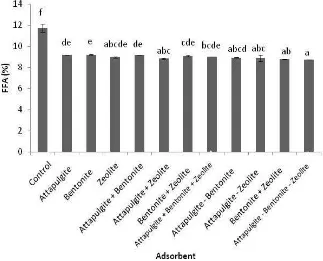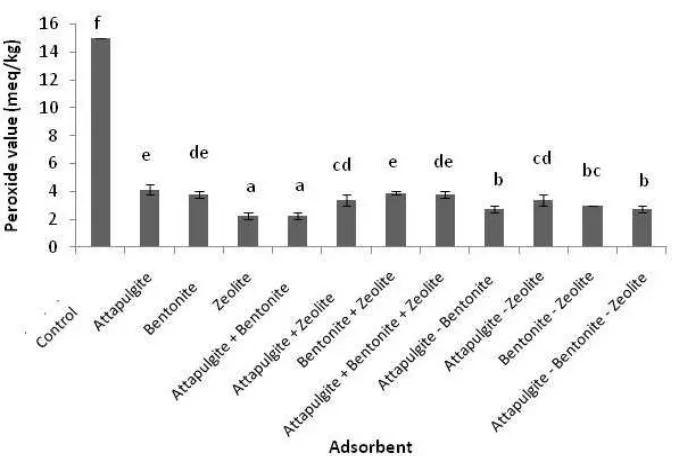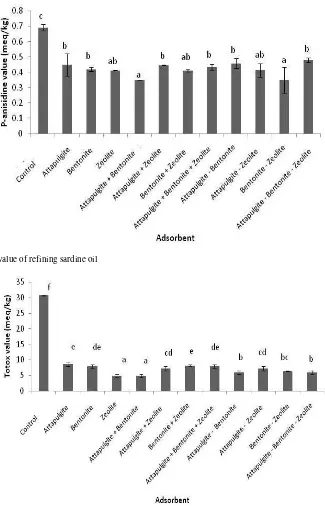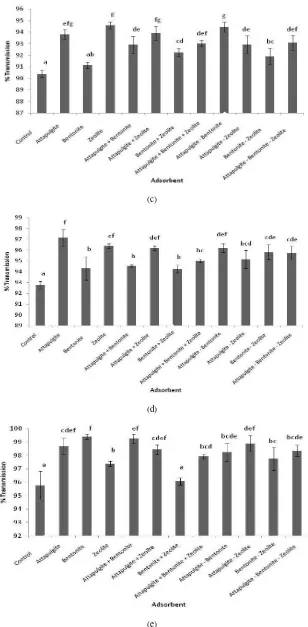Submitted: January 16, 2014 Accepted: January 25, 2014 Published: May 10, 2014
Corresponding Author: Sugeng Heri Suseno, Department of Aquatic Product Technology, Faculty of Fisheries and Marine Sciences, Bogor Agricultural University, Jl. Agatis Darmaga 16680 Bogor, Indonesia
Improving the Quality of Sardine Oil (
Sardinella
sp.) from Pekalongan-Indonesia
Using Centrifugation and Adsorbents (Attapulgite, Bentonite and Zeolite)
Sugeng Heri Suseno, Jeny Ernawati Tambunan, Bustami Ibrahim and Ayu Fitri Izaki Department of Aquatic Product Technology, Faculty of Fisheries and Marine Sciences,
Bogor Agricultural University, Jl. Agatis Darmaga 16680 Bogor, Indonesia
Abstract: Fish oil by-product is generally of poor quality and therefore cannot be directly used, so it must be purification. Fish oil purification can be done by treatment centrifugation and addition adsorbent. The purpose of this study is to determine the best treatment addition adsorbent to improve the quality of fish oil. Fish oil purification is done by treatment using centrifugation and then adsorbed by the adsorbent. The lowest peroxide value on providing a combination of adsorbent attapulgite bentonite, amounting to 2.250 meq/kg. The lowest P-anisidine value on providing a combination of adsorbent attapulgite bentonite was 0.348 meq/kg. The lowest value of the total oxidation on addition adsorbent attapulgite bentonite combination of 4.848 meq/kg. Lowest value of free fatty acids in the addition of adsorbent attapulgite, bentonite and zeolite gradually, by 8.742%. The best transmission value obtained in combination treatment addition of synthetic adsorbents attapulgite and bentonite in fish oil first centrifuged.
Keywords: Centrifugation, passive filter, refining, sardine oil, secondary primary oxidation
INTRODUCTION
Fish oil by-product is generally of poor quality and therefore cannot be directly used. It is necessary for purification. Fish oil purification methods include centrifugation method and adsorbents. Methods of centrifugation are the separation of crude oil by a centrifuging manner so that the heavier the more will be thrown farther due to centrifugal force. While adsorption is the process of separating certain components of the fluid phase (solution) to the surface of the adsorbent. Separation occurs due to differences in molecular weight or porosity, causing some molecules are more tightly bound to the surface of the other molecule. Both methods have advantages. Centrifuging method is faster separation time and the level of oxidation that occurs is smaller. Suseno et al. (2011) have shown that treatment of centrifugation on purification of fish oil is more effective in reducing the stock of soap and impurities compared with using filter paper. Centrifugation is a method to remove solid particles, components such as free oxidation, heavy metals that cause an increase in peroxide value (Bhattacharya et al., 2008). While purification using adsorbent has an advantage in adsorbing impurities, including free fatty acids, oxidized components and color pigments (Giiler and Fatma, 1992; Lin et al., 1998; Maes et al., 2005; Eyüp and Celik, 2005; Bhattacharya et al., 2008). In addition, the adsorbent having selective adsorption power so often used in the bleaching process oil.
The combination of fish oil purification method by centrifugation and adsorbent is rarely done. In general, fish oil refining is done by two methods separately, so it is necessary to conduct further research on methods of centrifugation and adsorbent combinations to improve the quality of fish oil.
MATERIALS AND METHODS
The main material used in this study is sardine oil (Sardinella sp.) that taken from by-product fishmeal industry in Pekalongan, Central Java, Indonesia. Other supporting materials are the materials used for the analysis of the quality of fish oil in the form of distilled water, glacial acetic acid, chloroform, a solution of potassium iodine (KI) saturated solution of sodium thiosulfate (Na2S2O3) 0.1 N, 0.1 N KOH solution, phenolphthalein indicators, 96% ethanol, 1% starch, isooctan, reagent p-anisidine, n-hexane. Equipments used include erlenmeyer glass, aluminum foil, magnetic stirrer, digital scales, Pasteur pipette, burette, stative, stirrer, magnetic stirrer, 2500 UV-Vis spectrophotometer LaboMed brands, high speed refrigerated centrifuge himac brand HITACHI CR 21G, water bath, micro pipette, bulb, test tubes and pumpkin drinks.
by using a magnetic stirrer at room temperature for 20 min. After that, sardine oil centrifuge with 10.000 rpm for 10 min at 10°C.
Analysis of fish oil quality: Sardine oil purifying then analyzed free fatty acid value (AOCS, 1998, method No. Ca 5a-40), peroxide value (AOAC, 2000, method No. 965.33b), p-anisidine value (IUPAC, 1987, method No. 2.504), total oxidation value (AOCS, 1997) and clarity (wavelength 450, 550, 620, 665, 700 nm, respectively) (AOAC, 1995).
Data analysis: Result of purifying process was statistically processed using ANOVA by SPSS software version 16.0 to see the regression parameter coefficients, percent significance (confidence interval) and the pattern of interaction of factors that significantly influence the response.
RESULTS AND DISCUSSION
Free Fatty Acids value (FFA): Formation of free fatty acids is due to the hydrolysis and oxidation of oil caused by the presence of free radicals and the decomposition of the double bond during heating (Paul and Mittal, 1997). Indication of the degree of hydrolysis that occurs in the oil can be determined by the content of free fatty acids (Berger, 1997). Bimbo (1998) suggest specification quality crude fish oil with a free fatty acid content ranged from 1 to 7%, but typically
ranges from 2 to 5%. Sardine oil free fatty acids value after addition of adsorbents can be seen in Fig. 1.
The value of free fatty acids before being addition adsorbent of 11.750%. The results showed that addition of adsorbent can reduce the value of free fatty acids effectively. Lowest value of free fatty acids in the addition of the adsorbent attapulgite, bentonite and zeolite gradually, by 8.742% with decrease of the percentage to 25.600% of free fatty acid value of the control. The highest value of free fatty acids in the addition of the adsorbent bentonite, amounting to 9.200% and the percentage decrease of 21.700% of the fatty acids of control.
The results showed that the addition of the adsorbent that sardine oil is centrifuged in advance can reduced the value of free fatty acids significantly. In addition of adsorbent treatment of sardine oil with first centrifuged, the value of free fatty acids of sardine oils range 9.200-8.742% and the percent decrease of 21.700-25.600% of the sardine oil control. Suseno et al. (2011) stated that the stock of soaps, phosphatide hydrated, gum and prooxidant metals as a fraction of the weight of the fish oil will be separated through centrifugation process. This implies a decrease in the levels of free fatty acids in fish oil that is purified. While the addition of the adsorbent is done to reduce the component pigments, free fatty acids, as well as other impurity components.
Peroxide value: Peroxide value was defined as the number of mill equivalents of active oxygen in the
Fig. 2: Peroxide value of refining sardine oil
peroxide contained in 1000 g of sample. Peroxide value indicates high fat or oil has been oxidized, but at a lower rate is not always indicate that the oxidation state is still early. Low peroxide value may be due to formation rate of new peroxide, smaller than the rate of degradation into other compounds, given the levels of peroxide degrades quickly and react with other substances (Raharjo, 2008). Peroxide value maximum
limit on fish oil is ≤5 meq/kg (IFOS (International Fish Oils Standard), 2011). Sardine oil peroxide value after the addition of adsorbents can be seen in Fig. 2.
Peroxide value of sardine oil before being given a adsorbent at 15 meq/kg. The results showed that addition of adsorbents effectively can reduce peroxide value. Lowest peroxide value on combination of addition adsorbent attapulgite and bentonite, amounting to 2.250 meq/kg and the percentage decrease of peroxide value was 85.000% of control. The highest peroxide value on providing adsorbent attapulgite, amounting to 4.125 meq/kg and the percentage decrease of 72.500% of the peroxide value of the control.
The results showed that the addition of the adsorbent of sardine oil that is centrifuged in advance can significantly reduced the peroxide value. In addition of adsorbent treatment of sardine oil with first centrifuged, peroxide value of sardine oil ranges 4.125-2.250 meq/kg and percent decrease was 72.500-85.000% of the sardine oil control. The high value of the adsorbent concentration allows the absorption of impurities component maximally, but it allows the natural antioxidants contained in the pigment absorbed, so can affect the oxidative stability of fish oil (Suseno et al., 2011).
P-anisidine value: P-anisidine value is the estimated value of the presence of the hydroperoxide compounds decomposition caused by further oxidation. The oil that has undergone further oxidation can have a low peroxide value because most of the hydroperoxide was oxidized to products or compounds of smaller breakdown products, so that the analysis is more accurate to describe the degree of damage to fish oil (Irianto and Giyatmi, 2009). The results of the analysis of p-anisidine addition synthetic adsorbents on sardine oil can be seen in Fig. 3.
P-anisidine value before being addition adsorbent of 0.791 meq/kg. The results showed that addition of adsorbent effectively can reduce p-anisidine value. The lowest p-anisidine value on treatment a combination of adsorbent attapulgite bentonite was 0.348 meq/kg and the percentage decrease of 56.082% of the control. The highest p-anisidine value on treatment adsorbent attapulgite of 0.498 meq/kg and the percentage decrease of 37.125% of the control.
Fig. 3: P-anisidine value of refining sardine oil
Fig. 4: Total oxidation value of refining sardine oil
high values of p-anisidine if the process is given in the fish oil allowing further degradation.
Total oxidation value: The total oxidation value can be used to measure the progression of the deterioration process that occurs in the oil and provide information on the formation of primary and secondary oxidation products (Hamilton and Rossell, 1986). The maximum limit on the total oxidation value of fish oil ≤5 meg/kg (IFOS (International Fish Oils Standard), 2011). The
total oxidation value of sardine oil after addition of adsorbents can be seen in Fig. 4.
adsorbent attapulgite of 8.848 meq/kg and the percentage decrease of 71.134% of the value of total oxidation control.
The results showed that the addition of the adsorbent of sardine oil that is centrifuged in advance can reduce the total oxidation value significantly. In addition of adsorbent treatment in sardine oil with first centrifuged, the total oxidation value of sardine oil ranged 8.848-4.848 meq/kg and percent decrease of 71.134-84.184% of the sardine oil control. The total oxidation value is the sum of between the two peroxide values with p-anisidine value (Perrin, 1996).
Clarity value: Measurements oil clarity performed on 5 wave length, i.e., 450, 550, 620, 665 and 700 nm, respectively. Oil clarity indicated by percent values were read on a spectrophotometer transmission. Value percent of high transmission and approaching 100% indicates that fish oil was observed to have a good level of clarity. The results of the analysis of percent light transmission of the sardine fish oil was addition adsorbents can be seen in Fig. 5.
The results showed that an increase in percent light transmission of the sardine oil at various wavelengths
(a)
(c)
(d)
(e)
tested in line with the addition of adsorbents. The best transmission value obtained in combination treatment addition of adsorbents attapupulgite and bentonite in sardine oil first centrifuged. Increasing the value of sardine oil transmission that addition adsorbents, inversely proportional to the peroxide value, p-anisidine and the total oxidation value. Gauglitz and Gruger (1965) states that the adsorbent can reduce the impurity components thereby increasing the value of percent light transmission to the oil sample.
CONCLUSION
The lowest peroxide value on providing a combination of adsorbent attapulgite bentonite, amounting to 2.250 meq/kg and the percentage decrease of 85.000% of control peroxide value. The lowest P-anisidine value on providing a combination of adsorbent attapulgite bentonite was 0.348 meq/kg and the percentage decrease of 56.082% of the control. The lowest value of the total oxidation on addition adsorbent attapulgite bentonite combination of 4.848 meq/kg and the percentage decrease of 84.184% of the total oxidation value control. Lowest value of free fatty acids in the addition of the synthetic adsorbent attapulgite, bentonite and zeolite gradually, by 8.742% decrease of the percentage of free fatty acid value to 25.600% of the control. An increase in percent light transmission of the sardine oil at various wavelengths tested in line with the addition of adsorbents. The best transmission value obtained in combination treatment addition of adsorbents attapulgite and bentonite in fish oil first centrifuged.
ACKNOWLEDGMENT
This study completion would not have been possible without the assistance of many people who gave their support. To them I would like to convey my heartfelt gratitude and sincere appreciation.
REFERENCES
AOAC., 1995. Official Methods of Analysis of the Association of Official Analytical Chemist. AOAC Inc., Washington, US.
AOAC,, 2000. Official Methods of Analysis of The Association of Agricultural Chemists, 17th Edn., AOAC Inc., Washington, US.
AOCS., 1997. Official Methods and Recommended Practices of the American Oil Chemists' Society. Official Method cd 8-53 Peroxide Value, cd18-90 p-ansidine Value, cg 3-91 Recommended Practices for Assessing Oil Quality and Stability. AOCS Press, Urbana, US.
AOCS., 1998. Official Methods and Recommended Practices of the American Oil Chemists Society. 5th Edn., AOCS Press, Champaign, US.
Berger, K.G., 1997. Industrial frying. Int. News Fats, Oils Related Mater., 8: 812-814.
Bhattacharya, A.B., M.G. Sajilata, S.R. Tiwari and R.S. Singhal, 2008. Regeneration of thermally polymerized frying oils with adsorbens. Food Chem., 110: 562-570.
Bimbo, A.P., 1998. Guidelines for characterizing food-grade fish oils. Inform. Int. News Fats Oils Relat. Mater., 9(5): 473-483.
Eyüp, S. and M.S. Celik, 2005. Sepiolite: An effective bleaching adsorben for the physical refining of degummed rapeseed oil. J. Am. Oil Chem. Soc., 82(12): 911-916.
Gauglitz, J.R. and J.R. Gruger, 1965. Bleaching and molecular distillation of menhaden oil. J. Am. Oil Chem. Soc., 42: 561-563.
Giiler, E. and T. Fatma, 1992. Chlorophyll adsorption on acid-activated clay. J. Am. Oil Chem. Soc., 69(9): 948-950.
Guillen, M.D. and N. Cabo, 2002. Fourier transform infrared spectra data versus peroxide and anisidine values to determine oxidative stability of edible oils. Food Chem., 77: 503-510.
Hamilton, R.S. and J.B Rossell, 1986. Analysis of oils and fats. Elsevier Appl. Sci.,London, pp: 23-32. IFOS (International Fish Oils Standard), 2011. Fish Oil
Purity Standards. Retrieved from: http:// www. omegavia. com/ best- fish- oil- supplement- 3 (Accessed on: September 10th, 2013).
Irianto, H.E. and S. Giyatmi, 2009. Fish Processing Technology. Universitas Terbuka, Jakarta, ID. IUPAC., 1987. Standard Methods for the Analysis of
Oils Arld Fats and Derivative. In: Paquot, C. and A. dan Hautfenne (Eds.), 7th Edn., Blackwell Scientific, Oxford, GB.
Lin, S., C.C. Akoh and A.E. Reynolds, 1998. The recovery of used frying oils with various adsorbents. J. Food Lipids, 5: 1-16.
Maes, J., B.D. Meulenaer, P.V. Heerswynghels, W.D. Greyt, G. Eppe, E.D. Pauw and A. Huyghebaert, 2005. Removal of dioxins and pcb from fish oil by activated carbon and its influence on the nutritional quality of the oil. J. Am. Oil Chem. Soc., 82(8): 593-597.
Paul, S. and G.S. Mittal, 1997. Regulating the use of degraded oil/fat in deep-fat /oil food frying. Critical Rev. Food Sci. Nutrient, 37(7): 635-662. Perrin, J.L., 1996. Determination of alteration. In:
Karleskind, A. and J.P. Wolff (Eds.), Oils and Fats. 2nd Edn., Lavoisier Publishing, Paris.
Raharjo, S., 2008. Protecting oxidation damage in oil during frying with antioxidants. Food Rev. Indonesia, 3(4).



